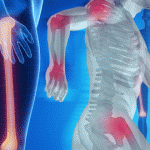Progression with Aging
In the deep part of the trochanteric hip is the gluteus minimus, and here, tendon pathology and muscle atrophy increase with age, correlating with the progression of tendinosis to tendon tears, she said.30 This muscle shows fatty degeneration earlier than the gluteus medius, and atrophy on the anterior part of the muscle seen on an MRI can also predict falls in older adults.31 After total hip arthroplasty, some patients will experience greater trochanteric pain syndrome due to atrophy in the gluteus medius and minimus.32
Bursae are located over the lateral, posterosuperior and anterior facets of the hip, including the trochanteric or gluteofemoral bursa, which is often implicated in painful trochanteric bursitis. It is located caudal to the greater trochanter, beneath the iliotibial tract, where the gluteus maximus’ tendinous fibers are inserted, and it separates the iliotibial tract from the vastus lateralis.
“Bursitis can also be associated with the inflammatory pathology of the hip. That means in a patient with inflammation, you can have bursitis,” said Dr. Möller, who showed ultrasound images of an inflamed hip joint with distension of the hip capsule tissues and bursitis next to the gluteus minimus. Ultrasound-guided, local injection of corticosteroid into the affected hip “will produce an initial reduction in pain with 72–75% reported positive response at four weeks.”33
The iliotibial tract (ITT) is a longitudinal, fibrous band created by opposing forces pulling on the fascia lata, the deep fascia investing the muscles of the hip and thigh, she said. Proximal ITT syndrome includes degenerative tears of this fibrous band, which can occur in middle-aged to elderly women even when there has been no trauma. Proximal ITT syndrome may also be an overuse injury that causes pain and tenderness at the iliac tubercle.34 The ITT may compress the tendons at the gluteus medius and minimus at their trochanteric insertion in the excessive hip adduction position or at high ranges of hip flexion, causing clinical symptoms like lateral hip pain with prolonged sitting and difficulty rising from a chair.35
A thickened posterior ITT band moving over the external greater trochanter can be one of many causes of external snapping hip syndrome, Dr. Möller said. Contraction of the huge gluteus maximus may transmit force to the ITT and the fascia lata, and this pathology may contribute to distal ITT syndrome.36 Prolonged sitting may result in shortening of the tensor of the fascia latae, which may produce an anterior tilt of the pelvis and/or a medial rotation of the femur.

